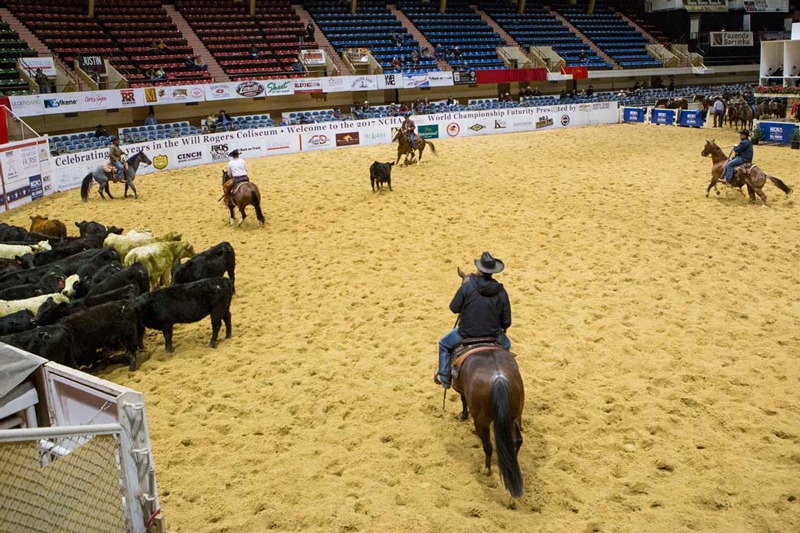They may not take center stage, but cutting wouldn’t work without them. We share the stories of five great turnback horses that exemplify the traits that make these support players invaluable to the sport.

Just outside the limelight at any cutting in the country, you’ll find a special set of horses. They don’t nab the headlines, take home the big checks or retire to a life of leisure in the breeding barn. But their contribution to the sport of cutting is incalculable. We’re talking about turnback horses, the unsung heroes of the sport. Here, we showcase a small handful that have not only helped cutting competitors earn millions of dollars over the years, but that also represent all the traits that go into making a superior turnback horse.
A Dash of Cow Sense
“They need to be solid, athletic horses, and they need to have cow,” said Mike Kelly, NCHA assistant executive director and director of national sales. “Maybe not enough to be an open competitor, but most turnback horses are on the verge of being a good cutting horse.”
Such was the case with Ascension Banuelos’ horse Brownie. Before the Banuelos family bought him, he was trained as a Futurity horse and was shown extensively. “He won some good money, and people say he marked [74s] and [75s]. He was a neat little horse,” said Ascension’s wife Tiffani.
Brownie was also a little too smart for his own good. When an amateur competitor purchased him, the gelding soon learned that his new rider wasn’t the one in control. Brownie started running out on him, and the Banuelos family ended up with a new horse.
Brownie became the first competition horse for their son Adan. “The first time Adan went to a show, he was 6 or 7,” said Tiffani. “He took Brownie and got a little check. Brownie hadn’t even been tuned up.”
Despite his show-pen exploits, Brownie found a higher calling as a turnback horse. “He was so talented he could almost do it himself,” Ascension said.
Ascension recalled one time watching cattle as they were being settled. He was sitting on Brownie in the pen when a cow slipped out of the herd and bolted toward the warmup area. “He just jumped up and got him on his own!” he said.
Somehow Ascension kept his seat, and Brownie got his cow turned.
Matlock Rose also remembers the talents of his Leo San turnback horse, Redwood San. “I worked cattle on him all the time, and [at cuttings] I’d loan him out to friends whose helper horse may have been injured,” said Rose. “Whether the rider knew what they were doing or not, he’d handle the cow.”
And Buster Welch fondly recalls his former turnback horse Rabbit: “He was such an honest, good cowhorse. You could put people on wanting to learn cutting, and he’d win amateur cuttings with them.”
Kid Worthy
“They need to be calm,” said Kelly. “You can’t have your turnback horse prancing up and down in front of the herd or acting up. If you were looking for a good kid’s pony, these are that kind of horse. Nothing fazes them. There have been several that have even been ridden into nightclubs and bars. And you have to have a calm horse to do that!”
Rabbit is a case in point. “It takes a goodnatured, cool-headed horse to turn back,” Welch said. “Rabbit could work all day and not get nervous. One time, Amarillo Slim borrowed him and rode him right into a casino in Las Vegas. He played poker on Rabbit, rolled the dice on him and rode him all through that casino.”
But that’s not all. According to Welch’s wife Sheila, Rabbit and another top-notch Welch turnback horse called Enchilada really were ideal kids’ mounts. “We have ten grandchildren, and all ten have ridden both horses,” said Sheila. “We even lend Enchilada to some of the grandkids’ friends for high school rodeo.”
The Banuelos family tells a similar story about Brownie. “He’s a really good turnback horse, and he’s sweet,” said Ascension’s 12-year-old daughter Erica. “Anybody can ride him. All of my cousins ride him. He was my brother’s horse, and then my sister’s, and now he’s mine.”
Broke as Can Be
“These horses have got to be broke to do just about anything,” said Kelly. “A lot of cutting horses don’t have a good handle, but a turnback horse has to have a good handle. He has to move where and when you tell him to.”
Rose agrees. “My honest opinion is, if you can’t help a fella on a horse, if you can’t get your horse turned and you can’t get him where you need to be, then you’re in the wrong place and you’re on the wrong horse. A good turnback horse has got to be broke.”

As an example, Rose cites his former half-Thoroughbred turnback horse, another one named Brownie.
“He was about as handy a horse as I’ve had,” Rose recalled. “He had a lot of smarts about what you were doing. You could show him what you wanted, and he’d do it. And you could do whatever you wanted on him. But he didn’t like a rope under his tail,” Rose said with a laugh. “It got under there one time, and he about bucked me off!”
Welch’s turnback horses were also dead broke and multi-talented. “Rabbit could just figure out anything you wanted to do,” Welch said. “And Enchilada, he had been the Super Horse back-to-back years at the Wichita Falls Ranch Rodeo, and then he was Super Horse two years running at the Abilene Ranch Rodeo. He could rope, cut, heel, head. My son-in-law won the Coors Light Heeling Championship on him.”
What’s more, added Sheila, “The grandkids have done barrel races, cutting and ranch work on him.”
In fact, Enchilada, although now 23 years old, still goes to the youth and high school cuttings.
“To me, these two horses, in their own right, were at the same level as [Thoroughbred racehorse] Cigar,” Sheila said. “They were so intelligent. You could put up kids or advanced riders. They were just incredible in their own fields, which was pretty much everything!”
A Whole Lotta Love

There’s one other quality that distinguishes a good turnback horse from a great one, and that’s the ability to stamp their presence and their personality on your memory — in short, to become respected, admired and even loved by those who have known them. Certainly Rabbit, Enchilada, Redwood San and the two Brownies fit this bill.
Take, for instance, the ease with which Rose recalls the special attributes of Redwood San and his own Brownie — horses he rode 20–30 years ago. And the way he recalls Brownie as a horse that “had a lot of heart,” while stating with admiration that Redwood San “sure enough knew the difference between settling a cow and turning back.”
The same spirit is even more pronounced when you talk to Buster and Sheila about Rabbit and Enchilada.
“They were just phenomenal in the cutting pen,” Sheila said. “They were so extremely reliable and unflustered.”
Buster added, “There were more people wanting to cut and turn back on Rabbit. Why, back then, I’d turn back for half the people at a cutting. He probably turned back on $5 million worth of winnings.
“We had him from 1974 until he died here three years ago, and we buried him right here on the ranch.”
The Banuelos family, too, has no qualms about telling the world how much Brownie means to them. “He was one of the best turnback horses, and all the famous trainers loved to turn back on him if they didn’t have their own horse,” said Ascension. Tiffani added, “A bunch of big-name people who’ve come through our barn have taken lessons on him.”
These days, the 23-year-old Brownie is taking some time off with a set of sore hocks. “I don’t know if we’ll ever get him sound,” said Tiffani. “But if we don’t, he’s certainly earned his spot in the pasture.”
After all, added daughter Erica, “I just love him. He’s Brownie the Champ!”
And our hats are off to you, Brownie –– as well as to all the other turnback horses that play the game day in and day out, doing their job with steady heads and true hearts, just outside the spotlight, so that our cutting horses can shine.
Article first appeared in the April 2005 issue of Performance Horse.



